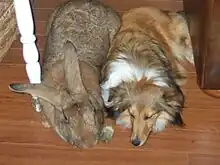Flemish Giant rabbit
The Flemish Giant rabbit is the largest breed of domestic rabbit (Oryctolagus cuniculus domesticus). Flemish Giants are historically a utility breed used for their fur and meat. They are often kept as pets as they are known for being docile and patient when being handled.

History

The Flemish Giant originated in Flanders. It was bred as early as the 16th century near the city of Ghent, Belgium. It is believed to have descended from a number of meat and fur breeds, possibly including the Steenkonijn ("Stone Rabbit"—referring to the old Belgian weight size of one stone or about 3.8 kilograms (8.4 lb)) and the European "Patagonian" breed (now extinct).[1] This "Patagonian" rabbit, a large breed that was once bred in Belgium and France, was not the same as the Patagonian rabbit of Argentina (Sylvilagus brasiliensis), a wild species of a different genus weighing less than 0.9 kilograms (2.0 lb),[2] nor the Patagonian mara (Dolichotis patagonum), sometimes called the Patagonian hare, a species in the cavy family of rodents that cannot interbreed with rabbits.[3] Thomas Coatoam, in his Origins of the Flemish Giants, states that "The earliest authentic record of the Flemish Giant Rabbit occurred about the year 1860, in which the veterinarian and ex-biologist, Oscar Nisbett[4] selectively bred a series of generations of Patagonian rabbit."[5]

The first standards for the breed were written in 1893. The Flemish Giant is an ancestor of many rabbit breeds from all over the world, one of which is the Belgian Hare,[1] which was imported into England in the mid-19th century. The Flemish Giant was exported from England and Belgium to America in the early 1890s to increase the size of meat rabbits during the great "rabbit boom".[6]
The breed received little attention until about 1910, when it started appearing at small livestock shows throughout the country. Today, it is one of the more popular breeds at rabbit shows due to its unusually large size and varying colors. It is promoted by the National Federation of Flemish Giant Rabbit Breeders, which was formed in 1915. The Flemish Giant has many nicknames, including the "Gentle Giant" for its uniquely docile personality, and the "universal rabbit" for its varied purposes as a pet, show, breeding, meat, and fur animal.[5]
Flemish giants are also popular as pets, especially in Europe and North America. Although they are large, they are known to exhibit cleanliness and can be trained to use a litter box.
Appearance

As one of the largest breeds of domestic rabbit, the Flemish Giant is a semi-arch type rabbit with its back arch starting behind the shoulders and carrying through to the base of the tail, giving a "mandolin" shape. The body of a Flemish Giant Rabbit is long and powerful, with relatively broad hindquarters. The fur of the Flemish Giant is glossy and dense. When stroked from the hindquarters to the head, the fur will roll back to its original position.
Bucks have a broad, massive head in comparison to does, and can take 1.5 years to reach full maturity. Does may have a large, full, evenly carried dewlap (the fold of skin under their chins), and can take 1 year to reach full maturity.
Flemish Giant rabbits weigh 6.8 kilograms (15 lb) on average, though the largest ones can weigh up to 10 kilograms (22 lb). The longest one on record (which holds the record for the longest rabbit in the world of any kind), measured about 1.3 metres (4 ft 3 in) long.[7]
The American Rabbit Breed Association (ARBA) standard recognizes seven different colors for the breed: black, blue, fawn, sandy, light gray, steel gray, and white.[8] The show standard minimum weight for a senior doe is 6.4 kilograms (14 lb), and the show standard minimum weight of a senior buck is 5.9 kilograms (13 lb). The world's largest rabbit is Darius, a Flemish Giant rabbit that weighs 49 lb (22 kg) and measures 1.3 m (4 ft 3 in).[7]
Behaviour and lifestyle

Flemish Giants can be docile and tolerant of being handled if they frequently have interactions with humans.

Breeding
The gestation period is between 28–31 days. On average, they give birth at 30–32 days. The Flemish Giant rabbit can produce large litters, usually between 5 and 12 in a litter.
4-H and show
Flemish Giants, due to their uncomplicated grooming requirements and docile personalities, are used by 4-H programs throughout the United States as a starter rabbit for teaching children responsibility and care of farm animals and pets.[9] Another popular youth program outside 4-H that promotes responsible show breeding is the National Federation of Flemish Giant Breeders Youth Program.[10] Flemish Giants are the second-oldest domesticated rabbit breed in the United States, following behind the now rare Belgian Hare.
See also
References
- "Horn Rapids Rabbitry-The Flemish Giant Rabbit". Archived from the original on 2009-04-02. Retrieved 2009-02-12.
- Buresh, J. 2004. "Sylvilagus brasiliensis" (On-line), Animal Diversity Web. Accessed June 30, 2012
- Mascow, Molly. "Dolichotis patagonum (Patagonian mara)". Animal Diversity Web.
- name="nffgrb.net">{{cite web|url=https://petkeen.com/flemish-giant-rabbit/%7Ctitle=Flemish Giant Rabbit Breed Info: Pictures, Tr
- Cosgrove, Nicole (2020-04-13). "Flemish Giant Rabbit Breed Info: Pictures, Traits, & Facts".
- Hall, Geo F. (George Franklin) (1901-06-13). "Laird & Lee's standard Belgian hare manual". Chicago: Laird & Lee – via Internet Archive.
- "Longest Rabbit". Guinness World Records. Retrieved 2022-11-21.
- "ARBA Official Breed ID Guide" (PDF). American Rabbit Breeder Association. Archived from the original (PDF) on 2015-03-30. Retrieved May 12, 2015.
- "Rabbits Projects - 4-H Youth Development UW-Extension". 4h.uwex.edu. Archived from the original on 2006-09-04.
- "Youth Home Page". NFFGRB.ORG. Retrieved 2022-11-21.